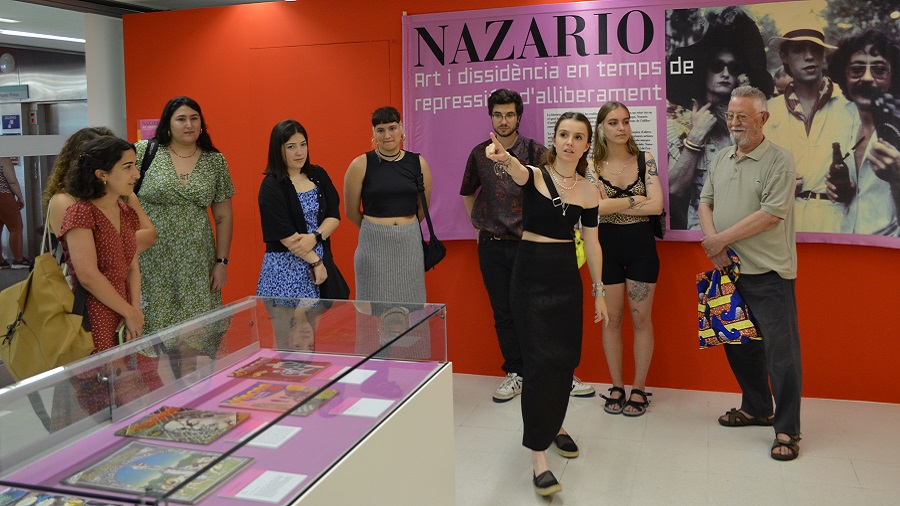Exhibition displays "vindications that become art" in the artwork of Nazario
The visual artist and illustrator Nazario Luque took part yesterday in the opening ceremony of the exhibition on his work "Art and dissidence in times of repression and liberation", which can be visited in the exhibition hall of the UAB Communication Library and General Newspaper Archives until 31 July and from 4 to 19 September (from 10 am to 7 pm, Monday to Friday). It is produced by Cultura en Viu and curated, in close collaboration with the artist, by students of the Art Criticism and Dissemination module of the UAB master's degree in Analysis and Management of the Artistic Heritage.

Virginia Luzón, Vice Rector for Communication and Culture at the UAB, began her inauguration speech by claiming the validity of the vindictive nature of Nazario's work, particularly since lately there has been news of aggressions against the LGTBIQ+ collective and other vulnerable groups. Vice Rector Luzón evoked the artist's period in the magazine El Víbora, referred to the great recognition that Nazario's work has achieved by reviewing its presence in the most prestigious museums, and thanked him for "the work carried out at the time as a vindication and that, today, has become art".
Pilar Adell, Councillor for Education, Democratic Memory and Museums and Historical Archives of the Cerdanyola del Vallès Town Council, welcomed the collaboration of the council with the University in the organisation of the exhibition and hoped that the exhibition, which can also be seen at the museum in her town, would have a long run. Jaume Vidal, lecturer of the master's degree in Analysis and Management of the Artistic Heritage, thanked the different people and organisations that made the exhibition possible, such as the Cerdanyola Art Museum - whose director, Josep Maria Romero, took part in the opening ceremony - and the Communication and Humanities libraries of the UAB, the designer Jesús Galdón and, of course, Nazario himself and the students.
Han comissariat la mostra Eva Alonso, Laia Bové, Darío Cadenas, Aina Canas, Josué Israel Fernández, Olga Folch, Ariadna Grifoll, Ainoa Llàcer, Marta Merino, Júlia Pons, María Rosenfeldt, Rut Soriano, Cristina Troya i Abigail Zamora. En l'acte de presentació les comissàries han explicat l'estructura de l'exposició, organitzada en tres blocs que repassen els inicis de la producció artística de Nazario i la seva oposició a la repressió dels darrers anys de la dictadura franquista, l'etapa posterior de maduresa en l'obra de l'artista i l'impacte de la sida en el col·lectiu LGTBIQ+, i la representació de la intimitat i de la sexualitat que marquen la seva obra més recent. L'exposició inclou també una entrevista a Nazario que es pot visionar en un espai adjunt a la mostra.
In charge of preparing the exhibition were Eva Alonso, Laia Bové, Darío Cadenas, Aina Canas, Josué Israel Fernández, Olga Folch, Ariadna Grifoll, Ainoa Llàcer, Marta Merino, Júlia Pons, María Rosenfeldt, Rut Soriano, Cristina Troya and Abigail Zamora. At the presentation ceremony, the curators explained the structure of the exhibition, organised in three blocks that review the beginnings of Nazario's artistic production and his opposition to the repression of the last years of Franco's dictatorship, the later stage of maturity in the artist's work and the impact of AIDS on the LGTBIQ+ collective, and the representation of intimacy and sexuality that mark his most recent work. The exhibition also includes an interview with Nazario that can be viewed in a space attached to the exhibition.
A re-reading of Nazario's work
Through a chronological journey that spans from the Spanish Transition to the present day, the artist's work is contextualised within the situation of the LGBTIQ+ collective in Spain, transporting the public to the socio-political moment in which each piece on display was created in order to fully understand its transgressive nature. The exhibition offers a re-reading of Nazario's career from the perspective of the curators, young people who did not live through the demands of the LGBTIQ+ collective in the past century but who, in some way, feel represented in them.
Nazario (Castilleja del Campo, Seville, 1944) is considered one of the pioneers in the artistic representation of themes related to homosexuality, sex and gender in the format of comic strips. His work, since the 1970s, has given visibility to the queer collective in an era marked by repression and sexual liberation. He is the author of an extensive comic oeuvre that includes the comic strips starring Anarcoma in the magazine El Víbora, as well as albums such as Alí Babá y los 40 maricones and Turandot. However, his work is multifaceted and also includes numerous paintings, lithographs and photographs, among others, often with intimate and social themes. The struggle for the liberation of the LGBTIQ+ community, gender, sexual freedom, the stigma of AIDS, immigration and social inclusion are some of the concerns he has expressed in his work, and he has become a countercultural leader and symbol of dissidence.
The UAB, with Sustainable Development Goals
Reduced inequalities